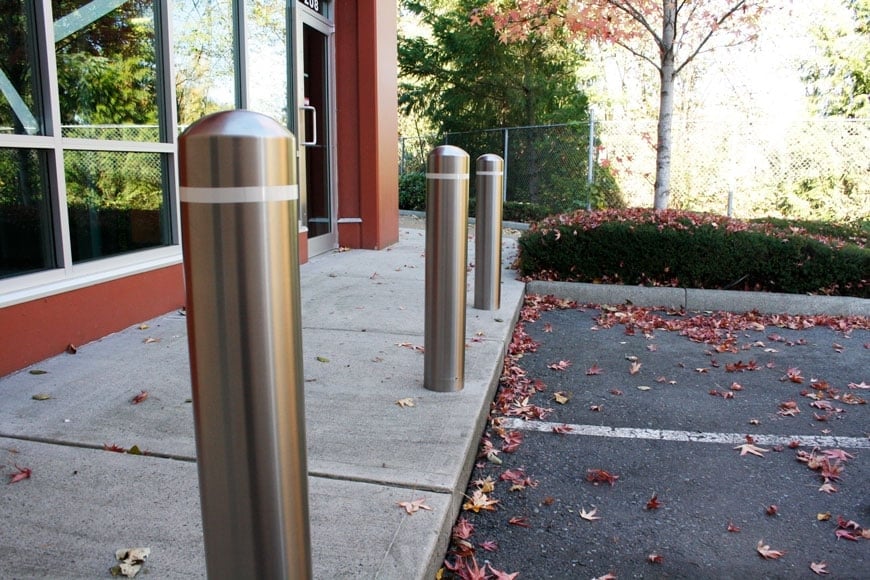Bollards play a crucial role in urban landscapes. They are everywhere – car parking facilities, parks and city streets. Bollards offer security, provide traffic management and demarcation of spaces. They are most often used outdoors, where they get exposed to the elements and can sustain various damage.
To ensure bollards remain effective, functional and visually appealing, it is important to remember that some maintenance is needed. In this guide, we'll explore the key practices that help maintain bollards in optimal condition, guaranteeing their longevity and functionality.
Routine Inspections
Firstly, like with any property, we recommend you walk around your perimeter and inspect your bollards regularly. Sometimes there is a big bang, and you definitely know a car has mistakenly reversed into one of your bollards, but most other times, the damage won't be catastrophic, and it would have happened quietly.
This is why regular inspections are the foundation of bollard maintenance. You should schedule periodic checks to identify any signs of wear, damage, or potential issues that may have started developing. A popular problem is foundations getting loose if bollards have been hit light enough to make them wobble but not hard enough but dislodge them. So, look for dents, scratches, rust, loose bolts, and wobbling, essentially and any deviations from the bollards' original position.
Addressing Minor Repairs
Like in the scenario above – a shaky foundation from a car bumping into a bollard, small issues can escalate if left unattended. The slight loosening of the foundations can look like a minor problem, but it means that if there is a second hit to the bollard, it may not provide any protection at all and just get run over without much resistance. This would ultimately defeat the purpose of the bollards, so it is always a good idea to promptly address minor repairs, such as tightening loose bolts, replacing missing caps, or fixing small dents. Neglecting these minor problems can lead to more significant damage and increased maintenance costs in the long run, as you will likely just need to replace the bollards.
Lubrication and Moving Parts
Proper lubrication is crucial to ensure smooth operation for bollards with moving parts, like retractable or telescopic bollards. So, make sure you include that in your maintenance schedule. The specifics will entirely depend on the model of bollard you have, but usually you need to use a lubricant in places like hinges, mechanisms, and joints. This is to help prevent friction-related wear and tear, and extend the bollard's lifespan.
Cleaning Techniques
There are a variety of materials that bollards can be made of, and some require very little maintenance. However, even the best-grade stainless steel bollard could benefit from a wipe, even if it is just for aesthetic reasons.
Moreover, cleaning keeps bollards looking polished and prevents the accumulation of dirt and debris that can lead to corrosion over time.
Depending on the material, use appropriate cleaning methods such as:
-
Stainless Steel: Clean with mild soap and water and a stainless steel cleaner to maintain its lustre.
-
Cast Iron: Gently scrub with a wire brush or fine sandpaper to remove rust, then apply a rust-resistant coating.
-
Painted Bollards: Wash with water and mild detergent, then repaint any chipped or faded areas. For this to work, it would be a good idea to make a note of the original RAL colour you ordered your bollard in.
Corrosion Prevention
Firstly, when deciding on the model and make of the bollard, ensure you choose the best material for your environment. This should give you a head start when it comes to maintenance and prevention. Corrosion is a common enemy of bollards, particularly those exposed to the elements, so once you’ve settled on a model, look for preventive measures like:
-
Galvanisation: Many of our bollards come in steel and stainless steel versions. We recommend choosing galvanised steel as an add-on whenever you select the steel one. The galvanisation process coats the bollard with a zinc layer, providing excellent corrosion resistance.
-
Powder Coating: People often want a particular colour, so we often provide that option. Applying a layer of powder coating serves the dual purpose of giving you an extra protective powder coating layer to metal surfaces, forming a durable barrier against moisture and chemicals and a specific aesthetic look.
-
Sealants: If applicable, select products with a sealant for gaps and joints to prevent water infiltration, reducing the risk of rust formation.
Professional Maintenance
Consider partnering with professional maintenance services for complex bollards or more extensive installations. Their expertise ensures thorough inspections, timely repairs, and adherence to industry standards, ultimately saving you time and money.
Regular maintenance is a key investment in the longevity and functionality of bollards. By following these practices, you can ensure that bollards continue to serve their intended purpose while contributing to the aesthetics and safety of their surroundings. With routine inspections, proper cleaning, and timely repairs, you'll maximise the value and lifespan of these essential urban elements.
